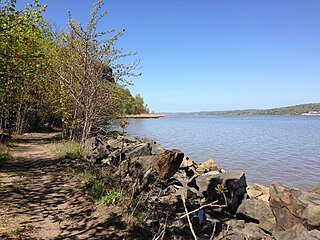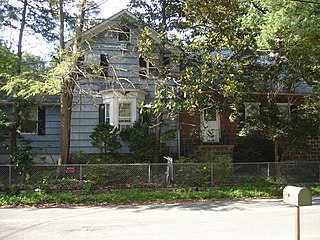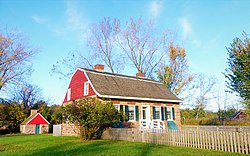
Bergen County is the most populous county in the U.S. state of New Jersey. As of the 2020 United States Census, the county's population was 955,732, an increase of 50,616 (5.6%) from the 905,116 residents enumerated in the 2010 census by the United States Census Bureau, which in turn represented an increase of 20,998 (2.4%) from the 884,118 counted in the 2000 Census. Located in the northeastern corner of New Jersey and its Gateway Region, Bergen County is part of the New York City metropolitan area and is directly across the Hudson River from Manhattan, to which it is connected by the George Washington Bridge.

River Edge is a borough in Bergen County, New Jersey, United States. As of the 2010 United States Census, the borough's population was 11,340, reflecting an increase of 394 (+3.6%) from the 10,946 counted in the 2000 Census, which had in turn increased by 343 (+3.2%) from the 10,603 counted in the 1990 Census.

New Milford is a borough in Bergen County, New Jersey, United States. As of the 2010 United States Census, the borough's population was 16,341, reflecting a decline of 59 (-0.4%) from the 16,400 counted in the 2000 Census, which had in turn increased by 410 (+2.6%) from the 15,990 counted in the 1990 Census.
New Bridge was a prosperous mill hamlet, centered upon a bridge strategically placed at the narrows of the Hackensack River. In the American Revolution, New Bridge Landing was the site of a strategic bridge crossing the Hackensack River, where General George Washington led his troops in retreat from British forces November 20, 1776. Eleven engagements took place here throughout the war. The current Draw Bridge at New Bridge was installed in 1889 and added to the National Register of Historic Places on July 5, 1989. The area is now a New Jersey historic site in portions of New Milford, River Edge, Hackensack and Teaneck in Bergen County, New Jersey, United States.

The Steuben House is a noted example of Bergen Dutch sandstone architecture, located at New Bridge Landing on the Hackensack River in River Edge, in Bergen County, New Jersey, United States.

Raritan Landing is a historical unincorporated community located within Piscataway Township in Middlesex County, New Jersey, United States, which was once an inland port, the farthest upstream point ocean-going ships could reach along the Raritan River, across from New Brunswick. Begun in the early 18th century it remained vital until the mid 19th century, when most of the port was abandoned.

The New Milford Plant of the Hackensack Water Company was a water treatment and pumping plant located on Van Buskirk Island, an artificially created island in the Hackensack River, in Oradell, Bergen County, New Jersey, United States. The site was purchased in 1881 by the Hackensack Water Company, which developed it for water supply use. The facility was built between 1881 and 1911, and it includes a brick pumping station from 1882, a tall filtration tower, and huge underground infrastructure. The Hackensack Water Company was merged into United Water in the 1980s; the successor today is Suez North America.

The River Road School is located in Lyndhurst, Bergen County, New Jersey, United States. The schoolhouse was built in 1893 and is the home of the Lyndhurst Historical Society. The schoolhouse was added to the National Register of Historic Places on November 11, 1977.

The Westervelt–Ackerson House is located in Ramsey, in Bergen County, New Jersey, United States. The house was added to the National Register of Historic Places on July 20, 1977.

The bridge at New Bridge Landing, New Jersey was built in 1888 to replace an earlier wooden one, and was added to the National Register of Historic Places on July 5, 1989.

The Albert J. Zabriskie Farmhouse is located at the current address of 7 East Ridgewood Avenue in Paramus, Bergen County, New Jersey, United States, just east of New Jersey Route 17. This is one of several Zabriskie historic sites associated with the descendants of prominent settler Albrycht Zaborowski (1638–1711). This stone house was built in 1805 by Albert Jacob Zabriskie (1760–1835) in the New Jersey Dutch style, owned by four generations of the family until 1924, and added to the National Register of Historic Places on November 7, 1977. Due to confusion from the street name and handwritten notes on one page of the NRHP nomination, the building is sometimes mistakenly listed as being in Ridgewood, New Jersey.

Demarest House is located in River Edge, Bergen County, New Jersey, United States. The house was added to the National Register of Historic Places on January 10, 1983, as part of the Early Stone Houses of Bergen County Multiple Property Submission (MPS).
David Bennett Mazur was an American politician and academic who served six terms in the New Jersey General Assembly, where he represented the 37th Legislative District from 1982 to 1992. Mazur also spent two decades as a professor at Ramapo College.

The Zabriskie Tenant House was a historic house of the American colonial architecture style called Dutch Colonial on Dunkerhook Road in Paramus, in Bergen County, New Jersey, United States, adjacent to the Saddle River County Park. The Zabriskie family, who farmed much of the area to the east of the Saddle River, built the home to house their domestic workers. It was one of the few structures left in New Jersey directly related to free African American communities in the state, and was a remnant of an African American Dunkerhook community that included several homes and an A.M.E. Church. The house was added to the National Register of Historic Places on July 24, 1984.

Blackledge-Kearney House, also known as Cornwallis' Headquarters, is located within the Palisades Interstate Park in Alpine, Bergen County, New Jersey, United States. The original, southern portion of the house was probably built in the 1760s, and the northern addition built around 1840. It was added to the National Register of Historic Places on July 24, 1984. Lord Cornwallis was believed to have used the house as a temporary headquarters during his crossing of the Hudson River in 1776, but modern historians dispute this claim.

Concklin-Sneden House is located in Rockleigh, Bergen County, New Jersey, United States. The house was built in 1796 and was added to the National Register of Historic Places on January 10, 1983.

East Jersey Old Town Village is an open-air museum located in Johnson Park in Piscataway, New Jersey. The Village is a collection of Raritan Valley area historic buildings and includes original, reconstructed, and replicated 18th and 19th century vernacular architecture typical of farm and merchant communities of Central Jersey. It is home to a permanent exhibition about Raritan Landing, an 18th-century inland port once located just downstream on the river. Since 1989, the Middlesex County Office of Arts and History has had responsibility for the village.

The Naugle House is a historic house of the American colonial architecture style called Dutch Colonial on Dunkerhook Road in Fair Lawn, New Jersey, adjacent to the Saddle River County Park. It was constructed in the 1740s or 1750s on a small hillside along the Saddle River and is approached from Dunkerhook Road via a roadway that permits access to the park. The National Park Service Heritage Documentation Programs Historic American Buildings Survey took photographs and made architectural drawings of the house in 1938, and the National Park Service added the Naugle House to the National Register of Historic Places on January 9, 1983.

Hamden is an unincorporated community located within Clinton Township, in Hunterdon County, New Jersey, United States.

Old Bridge, also known as the Historic Village of Old Bridge, is an unincorporated community located within East Brunswick in Middlesex County, New Jersey. It is on the South River, a tributary of the Raritan River. The community is named after the first bridge built here to cross the river, the South River Bridge. After other bridges were built crossing the river, it became known as the Old Bridge. The Old Bridge Historic District, encompassing much of the village, is listed on the state and national registers of historic places.





















